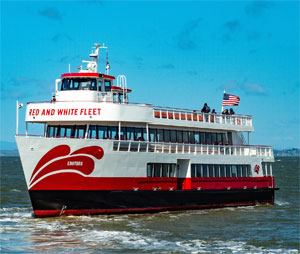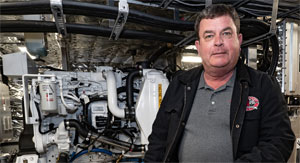Bucking a brisk March wind, Enhydra, the hybrid-propelled pride of San Francisco’s Red and White Fleet, made for the Golden Gate Bridge.
“I love the boat,” said Capt. Evan Williams, citing its responsive handling characteristics and stability, as he made the turn in the swells at the bridge. “She has a really high power-to-weight ratio because she is made of aluminum, and has a lot of torque instantly available that’s really nice in close quarters, such as docking.”
Despite the chilly off-season day, a respectable number of passengers boarded Enhydra for the bay tour. Although just 30 feet wide, the 600-passenger vessel is certified to accommodate 300 guests on its open third deck. Even the passengers braving the sharp wind on the upper deck experienced a smooth and quiet ride on a rough sea.
The 128-foot excursion boat — American Ship Review’s Ship of the Year for 2019 — is the first aluminum-hulled, battery-electric hybrid built from the keel up under U.S. Coast Guard Subchapter K regulations. It is named for Enhydra lutris, a Pacific Coast sea otter. Enhydra is also the largest “green” boat in the U.S. excursion fleet and, for Red and White, the first step toward the company’s goal of reaching zero emissions by 2025.
At first glance, Enhydra’s engine room appears more like a NASA-engineered configuration than that of an excursion vessel. However, Dan Johnson, Red and White’s director of operations and engineering, is at home amid the riot of electronics, wiring and gauges.
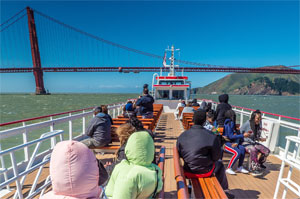 |
|
Passengers bundle up against a cold, brisk wind on the boat’s 300-passenger upper deck. |
The vessel’s propulsion is provided by two independent power trains, each consisting of a 300-kW BAE HybriGen system and an 80-kW Corvus Orca energy storage system. The Corvus lithium-ion battery bank is housed in a separate climate-controlled fireproof room.
Each power train features a variable-speed Cummins QSL9 engine driving a permanent magnet integrated starter generator. The generator is wired to a propulsion control system that directs power to the batteries or AC traction motor to propel the boat or to charge the batteries. The engines run on 100 percent Neste MY Renewable Diesel, a low-carbon biofuel that further reduces greenhouse emissions by up to 80 percent.
On short, slow-speed cruises, Enhydra can operate solely on electric power for most — if not all — of the trip. On longer cruises where vessel speed, distances and weather conditions create larger load demands, the generators augment the batteries as required.
The battery room is designed to expand for additional banks in the future, which will enable Enhydra to be fully electric. Red and White Fleet is working on the shoreside infrastructure required to provide fast plug-in charging for the larger battery packs.
“The boat has a lot of technology in her,” Johnson said. “Our owner (Tom Escher) is a visionary and his goal is to achieve zero emissions. We’re getting there and this is a great first step. People are watching with interest.”
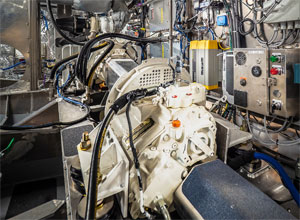 |
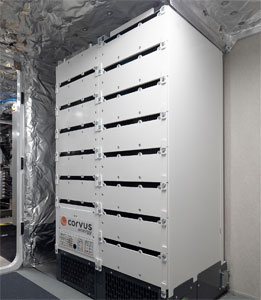 |
|
|
The power train aft of each main engine consists of an integrated starter generator and a propulsion control system linked to a 48-inch propeller. |
One of Enhydra’s two Corvus lithium-ion battery banks. |
|
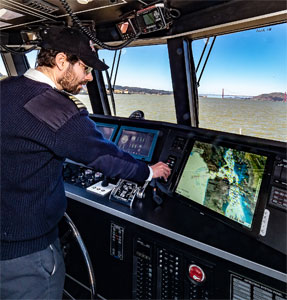 |
Enhydra “has a lot of technology in her,” says Dan Johnson, Red and White Fleet’s director of operations and engineering. Behind him is one of the excursion boat’s Cummins QSL9 mains, along with two boxes that house propulsion control components. |
|
|
Capt. Evan Williams adjusts the radar monitor as he takes Enhydra out on the bay. He gives high marks to the boat for its power-to-weight ratio and torque. |
|
Enhydra specifications |
| Owner/operator: Red and White Fleet, San Francisco, Calif. Designer/builder: Teknicraft, Auckland, New Zealand/ All American Marine, Bellingham, Wash. Dimensions: L: 128’ B: 30’ D: 6’ Mission: Hybrid electric excursion boat Crew size: Six |
|
PERFORMANCE PROPULSION NAVIGATION/COMMUNICATIONS CLASSIFICATIONS |

